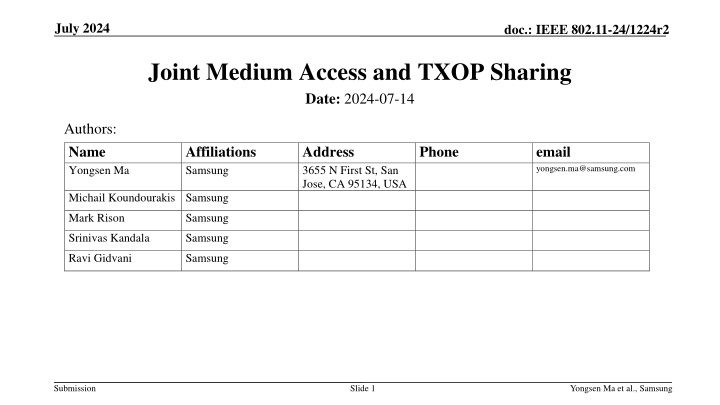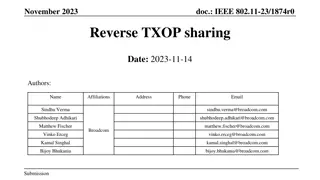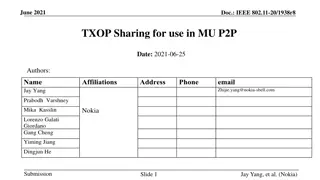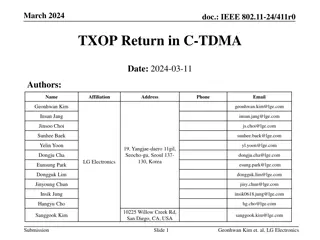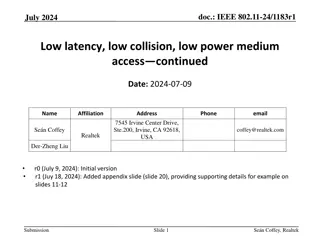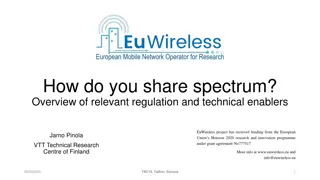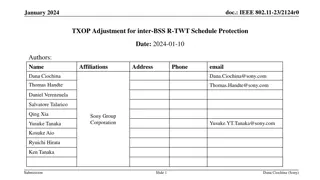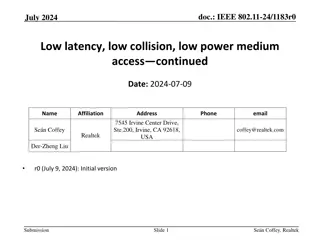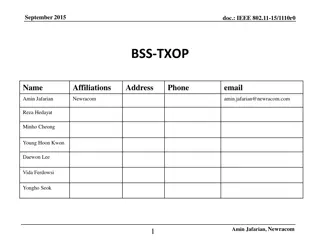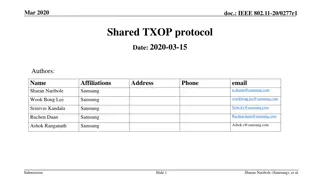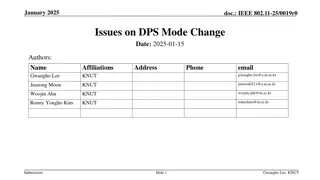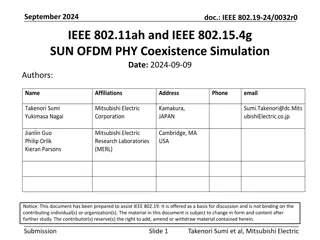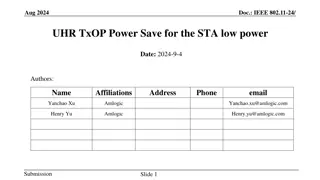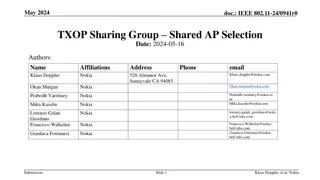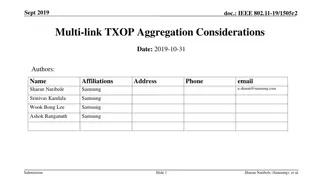IEEE 802.11-24/1224r2 Joint Medium Access and TXOP Sharing
Submission discussing mechanisms for medium access and TXOP sharing in 802.11 standard for UL/DL/P2P traffic, including proposals for extending TXOP sharing for multi-user scenarios and P2P transmissions.
Download Presentation

Please find below an Image/Link to download the presentation.
The content on the website is provided AS IS for your information and personal use only. It may not be sold, licensed, or shared on other websites without obtaining consent from the author.If you encounter any issues during the download, it is possible that the publisher has removed the file from their server.
You are allowed to download the files provided on this website for personal or commercial use, subject to the condition that they are used lawfully. All files are the property of their respective owners.
The content on the website is provided AS IS for your information and personal use only. It may not be sold, licensed, or shared on other websites without obtaining consent from the author.
E N D
Presentation Transcript
July 2024 doc.: IEEE 802.11-24/1224r2 Joint Medium Access and TXOP Sharing Date: 2024-07-14 Authors: Name Yongsen Ma Affiliations Samsung Address 3655 N First St, San Jose, CA 95134, USA Phone email yongsen.ma@samsung.com Michail Koundourakis Samsung Mark Rison Samsung Srinivas Kandala Samsung Ravi Gidvani Samsung Submission Slide 1 Yongsen Ma et al., Samsung
July 2024 doc.: IEEE 802.11-24/1224r2 Abstract The 802.11 base standard defines mechanisms to access medium for UL/DL/P2P traffic. There are UHR proposals to extend TXOP sharing for multi-user and UL/DL/P2P traffic. This submission presents joint medium access and TXOP sharing: Trigger/polling/ICF initiated by non-AP STA, sent to non-AP STA or AP TXOP sharing initiated by non-AP STA, shared with non-AP STA or AP Medium access for DL data initiated by non-AP STA Submission Slide 2 Yongsen Ma et al., Samsung
July 2024 doc.: IEEE 802.11-24/1224r2 TXOP for UL/DL/P2P Traffic: Current Definition There are existing mechanisms for medium access for UL/DL/P2P traffic Each STA/AP tries to access the medium using CSMA and EDCA. UL/DL/P2P traffic may be in the same TXOP, for example, using TXS, RDG and MU cascading. When AP obtains medium access: it may initiate DL transmissions with certain STA(s). it may use trigger frame to initiate UL transmissions with certain STA(s). it may use TXS to allow the non-AP STA (as TXOP responder) to send UL data to AP (sharing mode 1) or send P2P data to another peer STA (sharing mode 2). When non-AP STA obtains medium access: it may initiate UL transmissions with AP or P2P transmissions with a peer STA. it may use RDG to initiate DL transmissions with AP, although not widely used. Submission Slide 3 Yongsen Ma et al., Samsung
July 2024 doc.: IEEE 802.11-24/1224r2 TXOP for UL/DL/P2P Traffic: UHR Proposals There are proposals to extend TXOP sharing for multi-user and UL/DL/P2P traffic When AP obtains medium access: it may share the TXOP with multiple STAs and/or bidirectional traffic: MU-RTS TXS [1], multi-user TXS [2], TXOP for relay [3] it may send advertisement of recommended P2P channels, e.g., time and channel info, for P2P group [5] When non-AP STA obtains medium access: it may share the TXOP for P2P and DL/UL traffic [4] it may share the TXOP with AP: reverse TXOP Sharing [6], non-AP STA initiated TXOP sharing [7, 8] Submission Slide 4 Yongsen Ma et al., Samsung
July 2024 doc.: IEEE 802.11-24/1224r2 TXOP for UL/DL/P2P Traffic: This Proposal The main focus of this submission are: non-AP STA initiating TXOPs for a group of STAs, for example, P2P, relay, proxy, mesh, soft AP, multi-AP for retrieving DL data from AP AP as TXOP holder for AP-to-AP or P2P traffic Proposal: joint medium access and TXOP sharing Trigger/polling/ICF initiated by non-AP STA, sent to non-AP STA or AP TXOP sharing initiated by non-AP STA, shared with non-AP STA or AP It enables medium access initiated by non-AP STA for retrieving DL data from AP or P2P data from peer STA(s) DL/UL/P2P transmissions in the same TXOP medium access as a group for trigger-based access within a group TXOP sharing within a group Submission Slide 5 Yongsen Ma et al., Samsung
July 2024 doc.: IEEE 802.11-24/1224r2 Proposal: Joint Medium Access and TXOP Sharing Each STA tries to access the medium by CSMA and EDCA. Trigger/polling/TXOP sharing initiated by non-AP STA TXOP is obtained and shared between a group of STAs. The TXOP is initiated by ICF (initial Control frame). If a certain STA, e.g., group leader, gets the TXOP, it may send trigger/polling frame and initiate transmissions with peer STA(s). If a STA other than the group leader gets the TXOP, it may transfer/share the TXOP to group leader to initiate transmissions with peer STA(s). Medium access initiated by non-AP STA to retrieve data from AP or peer STA Non-AP STA as TXOP holder for receiving data from other STAs. Non-AP STA needs to get DL data from the AP based on RX/L2 buffer status and other conditions. Non-AP STA adds a request/trigger/polling frame in TX queue to get TXOP for DL data. Submission Slide 6 Yongsen Ma et al., Samsung
July 2024 doc.: IEEE 802.11-24/1224r2 Example 1: Trigger Frame from Non-AP STA STA1 obtains TXOP and sends trigger frame (plus polling if needed) to STA2 and STA3 STA2 and STA3 transmit to STA1 based on the schedule STA1 sends data to STA2 and STA3 Trigger/polling frame can be initiated by only group leader, certain group STAs, or any group STA. Submission Slide 7 Yongsen Ma et al., Samsung
July 2024 doc.: IEEE 802.11-24/1224r2 Example 2: TXOP Sharing from Non-AP STA STA2 obtains TXOP and sends initial control frame (ICF) to STA1 to share the TXOP with STA1 STA1 sends trigger frame to STA2 and STA3 to initiate transmissions TXOP can be shared directly/indirectly with only group leader, only group leader and AP, only certain group STA(s), or certain group STA(s) and AP Submission Slide 8 Yongsen Ma et al., Samsung
July 2024 doc.: IEEE 802.11-24/1224r2 Example 3: Trigger Frame from Non-AP STA and TXOP Sharing for P2P/UL/DL STA1 obtains TXOP and sends ICF to STA2, STA3 and AP STA1 sends trigger frame to initiate P2P transmissions with STA2 and STA3 STA1 initiates UL/DL transmissions with AP ICF may be Unsolicited or solicited Integrated with other frames, e.g., trigger/polling frame Submission Slide 9 Yongsen Ma et al., Samsung
July 2024 doc.: IEEE 802.11-24/1224r2 Example 4: MU-RTS TXS from AP and Trigger Frame from Non-AP STA AP obtains TXOP and sends MU-RTS TXS trigger frame to STA1 to share the TXOP STA1 sends CTS response to AP STA1 sends trigger frame (plus polling if needed) to STA2 and STA3 STA2 and STA3 transmit to STA1 based on the schedule STA1 sends data to STA2 and STA3 AP sends data to STA1 after the allocated time specified in the MU-RTS TXS trigger frame Submission Slide 10 Yongsen Ma et al., Samsung
July 2024 doc.: IEEE 802.11-24/1224r2 Conclusion This contribution presents joint medium access with three different mechanisms: TXOP sharing initiated by trigger/polling/ICF by non-AP STA DL data transmissions from AP, initiated by non-AP STA It allows channel access being done in a semi-distributed way It does not require initiation by the AP to get the TXOP and does not increase complexity for the AP: there is no need to decide when and how to share the AP s TXOP. It avoids in-group contention/backoff and hence avoids potential collisions and wasted TXOPs due to two levels of contention from both inter-group and intra-group STAs. It provides additional options to get medium access for a group of STAs and can coexist with other options, e.g., EDCA, trigger-based access, TXS, and multi-STA TXOP sharing. Submission Slide 11 Yongsen Ma et al., Samsung
July 2024 doc.: IEEE 802.11-24/1224r2 References [1] 802.11-24/0403r0, Managed on-channel P2P communication, Inaki Val [2] 802.11-24/0536r0, Multi-user triggered TXOP sharing, Ronny Yongho Kim [3] 802.11-24/0105r0, TXOP for Relay communication in 11bn, Dongguk Lim [4] 802.11-24/0668r1, Data Forwarding within TXOP for XR Use Cases, Seongho Byeon [5] 802.11-24/0393r0, Enhancements on Off-Channel P2P Communications, Rubayet Shafin [6] 802.11-23/1874r0, Reverse TXOP Sharing, Sindhu Verma [7] 802.11-24/0686r0, STA initiated TXOP Sharing via Unicast CF-End, Pei Zhou [8] 802.11-23/1847r0, Non-AP initiated TXOP sharing follow-up, Sanghyun Kim Submission Slide 12 Yongsen Ma et al., Samsung
July 2024 doc.: IEEE 802.11-24/1224r2 Straw Polls SP1: Do you support allowing a non-AP STA initiate TXOP sharing with other non-AP STA(s) in TGbn? A non-AP STA may send a TBD frame, e.g., trigger frame, to other non-AP STA(s) to initiate trigger- based access. A non-AP STA may send a TBD frame, e.g., initial control frame, to other non-AP STA(s) to share its TXOP. Results: Yes: , No: , Abstain: Submission Slide 13 Yongsen Ma et al., Samsung
July 2024 doc.: IEEE 802.11-24/1224r2 Straw Polls SP2: Do you support allowing a non-AP STA initiate downlink transmissions with its associated AP in TGbn? A non-AP STA may send a TBD frame, e.g., trigger/initial control frame, to its associated AP to initiate downlink transmissions. Results: Yes: , No: , Abstain: Submission Slide 14 Yongsen Ma et al., Samsung
July 2024 doc.: IEEE 802.11-24/1224r2 Straw Polls SP3: Do you support allowing a non-AP STA initiate downlink/uplink transmissions with its associated AP and P2P transmissions with its peer STA(s) in the same TXOP in TGbn? A non-AP STA may send a TBD frame, e.g., initial control frame, to its associated AP and peer STA(s) to initiate downlink/uplink/P2P transmissions. Results: Yes: , No: , Abstain: Submission Slide 15 Yongsen Ma et al., Samsung
July 2024 doc.: IEEE 802.11-24/1224r2 Backup Submission Slide 16 Yongsen Ma et al., Samsung
July 2024 doc.: IEEE 802.11-24/1224r2 Trigger/Polling/ICF Initiated by Non-AP STA (1/2) Medium access is performed in a semi-distributed way, sometimes distributed and sometimes scheduled Distributed: each STA performs EDCA independently; TXS/control from AP is not needed Scheduled/Controlled: trigger/polling/ICF to initiate transmissions among a group of STAs This proposal does not require initiation by AP and does not increase the complexity for AP. It does not use the AP s TXOP that is acquired by contending with other STAs. It does not rely on the AP for some of the non-AP STA s transmissions. Submission Slide 17 Yongsen Ma et al., Samsung
July 2024 doc.: IEEE 802.11-24/1224r2 Trigger/Polling/ICF Initiated by Non-AP STA (2/2) It avoids in-group contention/backoff and hence avoids potential collisions and wasted TXOPs due to two levels of contention with both inter-group and intra-group STAs. It can get channel access quicker for high priority STA/traffic and to have grouped DL/UL/P2P traffic in the same TXOP. It provides additional options to gain medium access for a group of STAs and can coexist with other options, e.g., EDCA, trigger-based access, TXS, and multi-STA/-AP TXOP sharing. It is scalable for a group of STAs in multi-link/-BSS/-AP scenarios. Submission Slide 18 Yongsen Ma et al., Samsung
July 2024 doc.: IEEE 802.11-24/1224r2 Non-AP STA as TXOP Holder for DL Data (1/2) Non-AP STA needs to retrieve DL data from the AP, based on RX/L2 buffer status at the non- AP STA or more DL data indication from the AP or non-AP STA. Non-AP STA transmits a TBD frame that contains TXOP information (start time and duration) for DL data. It may be a short frame, e.g., request to receive frame, similar to RTS or CTS-to-AP a trigger/polling frame, e.g., as initial control frame alternatively piggybacking onto UL data frames by modifying the TBD fields of the MAC header It gives AP the indication of urgency of DL data that the non-AP STA is expecting. Submission Slide 19 Yongsen Ma et al., Samsung
July 2024 doc.: IEEE 802.11-24/1224r2 Non-AP STA as TXOP Holder for DL Data (2/2) After non-AP STA gets the TXOP and sends the request/trigger/polling frame to the AP: If the AP is ready to transmit, it may send a newly-defined response frame, similar to CTS, or send DL PPDU directly to the non-AP STA. If the AP is not ready to transmit, it may do nothing or send a response frame to the non- AP STA. Other STAs set NAV based on the request frame from non-AP STA and/or the response frame/DL PPDU from the AP. More data indication sent in the obtained TXOP, so AP/non-AP STA can take actions: If multiple links are active, more data indication can be provided on one link and data is transmitted on another link. More DL data indication may be in UL data (from non-AP STA) or BA (from AP). The request/trigger/polling frame may also be sent on other links. Submission Slide 20 Yongsen Ma et al., Samsung
